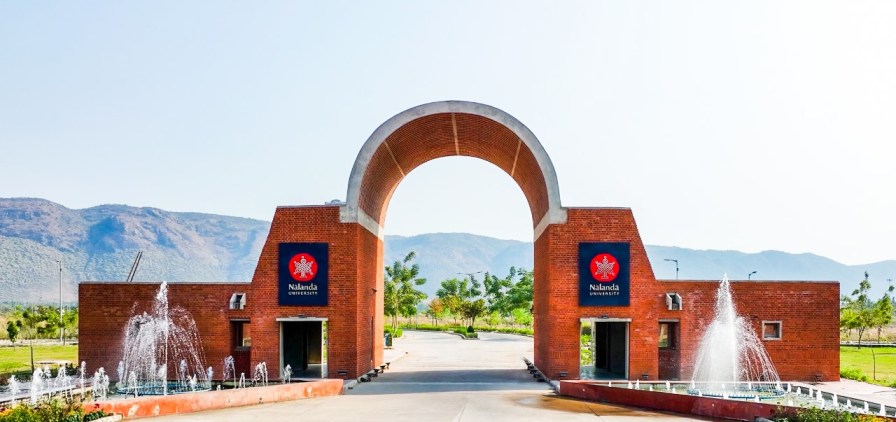Revival of Nalanda: A New Golden Age for India

Introduction
Nalanda University holds a special place in India’s rich educational history. Recently, Prime Minister Narendra Modi inaugurated the new campus of Nalanda University in Rajgir, highlighting its revival as a significant milestone for India’s educational landscape. PM Modi envisions this revival as the dawn of a new Golden Age for India, positioning Nalanda as a beacon of knowledge and cultural exchange on the global stage.
Historical Background
Nalanda University, founded in the 5th century AD, was a premier institution of learning in ancient India. Renowned for its rigorous academic environment and diverse student body, Nalanda attracted scholars from across Asia. However, the university met its demise in the 12th century due to invasions, leading to the destruction of its invaluable library and infrastructure. Despite its physical destruction, Nalanda’s legacy as a center of knowledge endured through centuries.
Modern Revival
The revival of Nalanda University marks a significant step in reconnecting with India’s educational heritage. The new campus, inaugurated by PM Modi, is a testament to India’s commitment to preserving and advancing its historical roots. The design of the campus embraces modern sustainability practices, making it a ‘Net Zero’ Green Campus.
Symbol of India’s Educational Heritage
The new Nalanda campus symbolizes India’s deep-seated reverence for education and knowledge. It serves as a bridge between the past and the present, linking India’s rich cultural heritage with contemporary educational practices. This revival is not just a renaissance of India’s past but also a celebration of global educational values.
Architectural Marvel
The Nalanda University campus is an architectural marvel designed to be self-sustaining and eco-friendly. The ‘Net Zero’ Green Campus incorporates solar plants, water treatment facilities, and extensive water recycling systems. This design ensures that the campus operates with minimal environmental impact, setting a standard for sustainable educational institutions worldwide.
A Global Educational Hub
Nalanda University aims to be a global educational hub, fostering international collaboration. Countries from the Association of Southeast Asian Nations (ASEAN) and the East Asia Summit (EAS) have actively participated in its reconstruction, reflecting the university’s role in promoting global academic exchange.
Educational Philosophy
Nalanda’s educational philosophy is rooted in inclusivity and diversity. Historically, the university welcomed students from various nationalities, emphasizing the universal nature of education. This philosophy continues in the modern revival, aiming to create a diverse and inclusive academic environment.
Impact on Modern Education
The revival of Nalanda University bridges ancient educational practices with contemporary methods. It integrates traditional knowledge systems with modern pedagogy, offering innovative teaching methods that cater to a global student body.
Cultural Exchange and Knowledge Sharing
Nalanda University plays a crucial role in cultural exchange and knowledge sharing. It undertakes documentation and preservation of various artworks from India and Southeast Asia, fostering a deeper understanding of regional cultures. The Common Archival Resources Centre at Nalanda is a significant step towards this goal.
International Yoga Day Connection
PM Modi highlighted the connection between Nalanda University and International Yoga Day, celebrated on June 21. Yoga, deeply rooted in Indian tradition, has gained global acceptance, much like the educational values promoted by Nalanda. This connection underscores India’s contribution to global well-being and knowledge.
Sustainability Initiatives
The new Nalanda campus embodies sustainability with its ‘Net Zero’ initiatives. It features solar energy systems, efficient water treatment and recycling plants, and extensive green spaces. These initiatives ensure that the campus operates sustainably, serving as a model for future educational institutions.
Campus Facilities
The Nalanda University campus boasts state-of-the-art facilities, including two academic blocks with 40 classrooms, two auditoriums with a capacity of 300 seats each, and a hostel accommodating around 550 students. Additional facilities include an international center, an amphitheater, a faculty club, and a sports complex, providing a comprehensive educational environment.
Future Aspirations
Looking ahead, Nalanda University aims to establish itself as a leading global education center. Ongoing projects and developments focus on expanding its academic offerings and enhancing its infrastructure, aligning with its vision of becoming a hub for knowledge and cultural exchange.
PM Modi’s Vision
PM Modi envisions India as a global center for education and knowledge. He emphasizes sustainable development and the importance of integrating progress with environmental responsibility. Nalanda University’s revival is a step towards realizing this vision, promoting education and sustainability.
Conclusion
The revival of Nalanda University marks a significant milestone in India’s educational journey. It reconnects with the country’s rich academic heritage while embracing modern sustainability practices. Nalanda stands as a symbol of India’s capability and vision, poised to lead the world in education and knowledge sharing.
FAQs
What is the historical significance of Nalanda University? Nalanda University, established in the 5th century AD, was a renowned center of learning in ancient India, attracting scholars from across Asia. It symbolized the pinnacle of knowledge and education before its destruction in the 12th century.
How is the new Nalanda campus sustainable? The new Nalanda campus is designed as a ‘Net Zero’ Green Campus, featuring solar energy systems, water recycling facilities, and other eco-friendly initiatives, ensuring minimal environmental impact.
What are the unique features of the new Nalanda campus? The campus includes modern facilities such as academic blocks, auditoriums, a student hostel, an international center, an amphitheater, and a sports complex, all designed to support a comprehensive educational environment.
How does Nalanda University promote cultural exchange? Nalanda University promotes cultural exchange through its inclusive educational philosophy, international collaborations, and documentation of regional artworks, fostering a deeper understanding of diverse cultures.
What is PM Modi’s vision for Nalanda University? PM Modi envisions Nalanda University as a global center for education and knowledge, emphasizing sustainability and cultural exchange. He aims to position India as a leading knowledge hub, integrating progress with environmental responsibility.

